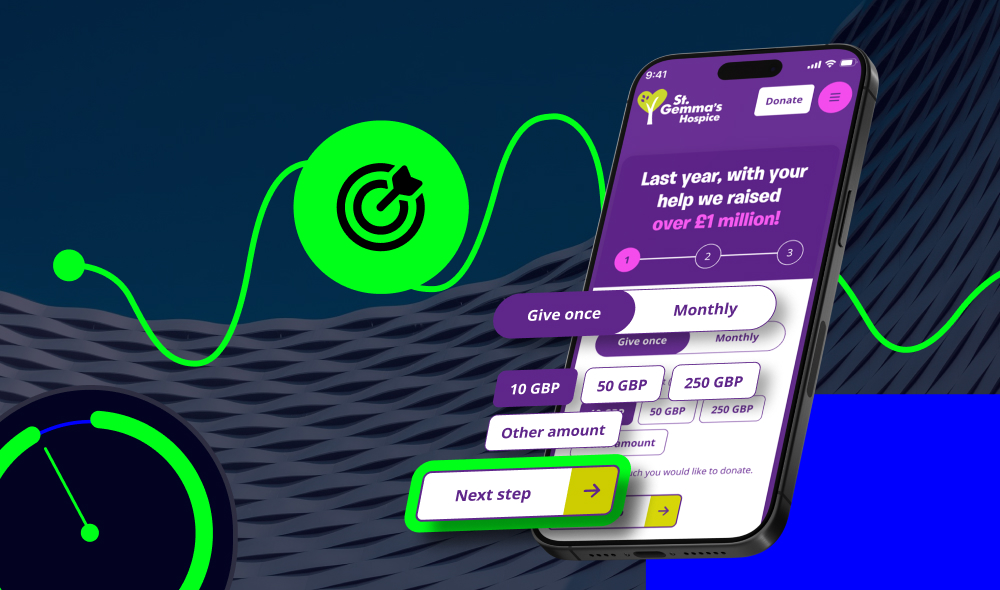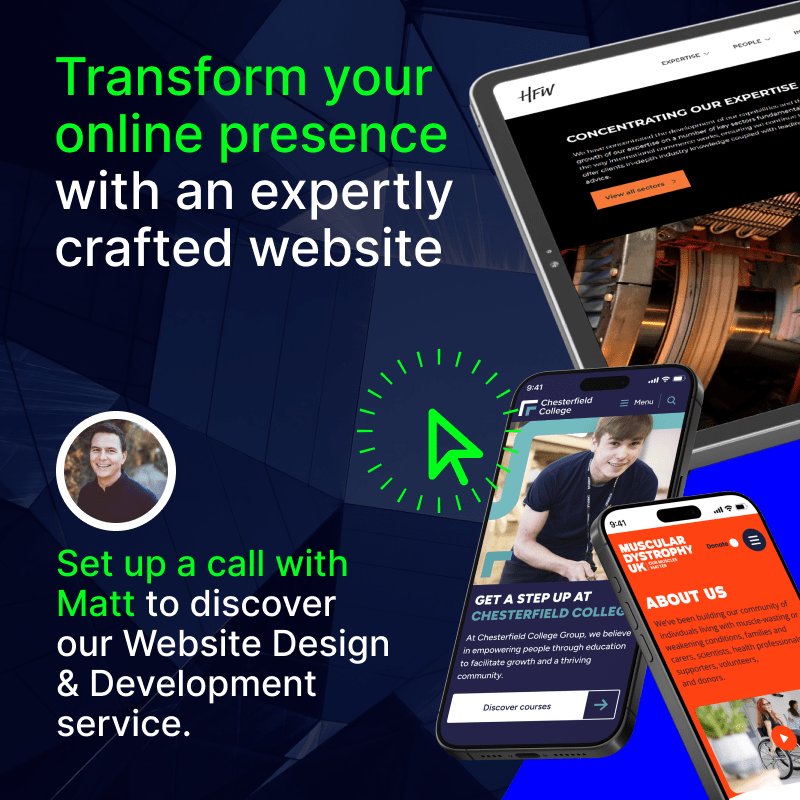4 Website Improvements for a More Impactful Digital Presence
Think about the last time you visited a frustrating website. Maybe it took forever to load, looked terrible on your phone or made it impossible to find what you needed. Did you stick around?
Probably not. And neither will your visitors if your website isn’t up to scratch.

Harry Hammett is a detail-driven Project Co-Ordinator at Itineris, ensuring seamless delivery across digital projects. With a keen eye for organisation and efficiency, he keeps teams aligned and clients informed, driving success through clear communication and meticulous planning.
The fact is, most websites underperform — not because businesses don’t care, but because they focus on the wrong things. Fancy design and trendy features mean nothing if your site is slow, clunky or impossible to update.
To make a real impact, you need to get the fundamentals right.
In this guide, we’ll break down four crucial improvements that will transform your website into something faster, smarter and built to last. No matter the scale of your site or what industry you serve, these website improvements will help you achieve better results from your digital presence.
1. Put the User Experience First
Any great website puts the visitor first.
People don’t come to your site for ads, pop-ups or excessive analytics scripts. They come for content, services or products.
So, if their experience is frustrating — slow load times, intrusive interruptions, or confusing navigation — they’ll leave. Prioritising user experience (UX) means making every interaction smooth, fast and engaging.
First, speed is crucial. If your site takes too long to load, users won’t wait.
Heavy third-party scripts, such as advertising and analytics tools, can slow things down. While these are important for business, they shouldn’t overshadow the visitor’s experience.
Consider delaying ad loading until key content appears, optimising images and minimising unnecessary scripts.
Of course, navigation must be intuitive. Users should find what they need without thinking. Logical menus, clear calls to action and a well-structured layout make all the difference. Cluttered pages or vague labels create frustration. Ensure your most important content is prominent and easy to access.
Keeping users happy also comes down to how your website presents content.
Visitors engage most with what they see first. So, load hero images and top-priority visuals before anything below the fold. If you use carousels, don’t waste resources preloading images users may never scroll to. Lazy-loading can ensure the page feels fast while still delivering everything in the background.
Every feature on your site should serve a purpose. Ask yourself: Does this help the visitor?
If an element exists only for business needs and disrupts the user experience, reconsider its placement or execution.
By putting UX first, you create a site that people enjoy using — and that keeps them coming back.
With all that said, the most important part of user-first web design is regularly monitoring user-behaviours, data insights and optimising your experience over time. Read our guide on user-centred design for more information on how to get this right.
2. Prioritise Performance
A fast website is essential. Visitors expect instant access to content, and any delays will drive them away.
Performance affects everything from user engagement to search rankings, so it must be a priority from the start.
The best-performing websites are built with speed in mind. This starts with strong foundations — choosing the right hosting, optimising server performance and using efficient coding practices.
A slow, bloated site can’t be fixed with last-minute tweaks. Performance needs to be part of the culture, influencing design, development and content decisions. This means performance optimisation should be an ongoing, standard practice, right from the day your new website goes live.
Core Web Vitals are key indicators of website performance. These metrics, such as Largest Contentful Paint (LCP), Cumulative Layout Shift (CLS) and Interaction to Next Paint (INP), measure how quickly users can see and interact with content.
A high LCP means slow loading times. A poor CLS score suggests elements shift unexpectedly, frustrating users. A lagging INP indicates sluggish responsiveness.
Optimising these provides a smooth, frustration-free experience. And if you keep your Core Web Vitals in good order, it will help both your search engine performance and your user experience.
As we said, performance monitoring should be continuous. Regular audits will help you uncover hidden issues before they affect visitors.
And optimisation isn’t a one-off task — it requires constant refinement. Compressing images, minifying code, reducing third-party scripts and using caching are all proven techniques to boost speed.
Prioritising performance means making smart trade-offs. Do you really need an autoplaying video on the homepage? Can you delay loading non-essential elements? Every decision should balance functionality with speed.
A culture of performance leads to better websites. When teams — from designers to developers — consider speed at every stage, the result is a site that’s not just fast, but consistently high-performing. This creates a better experience for users, improves conversions and ensures long-term success for your website.
3. Maintain Accessibility
Website accessibility may be a legal requirement, but really, it’s so much more than just a box to check off.
An inaccessible website locks out potential customers, damages your brand reputation and can even expose organisations to legal risks. Beyond the compliance aspect, accessibility ensures that everyone, regardless of ability, can navigate, understand and interact with your site. And the benefits go far beyond users with disabilities.
A significant proportion of people struggle with digital access. In the UK alone, two million people live with sight loss, and 8% of men have colour-vision deficiency. Many others experience mobility impairments, hearing loss or neurodiversity challenges such as dyslexia or ADHD.
If your website isn’t designed with these users in mind, you’re creating unnecessary barriers — barriers that lead to lost engagement, higher bounce rates and missed revenue opportunities.
Good accessibility starts with core principles: content should be perceivable, operable, understandable and robust. That means using high-contrast colours, providing alternative text for images, ensuring keyboard navigation works seamlessly and making sure content is structured logically.
It’s about designing with flexibility — allowing users to interact in ways that suit them best, whether through screen readers, voice commands or adaptive devices.
The commercial case for accessibility is undeniable. The so-called ‘Purple Pound’ — the spending power of disabled consumers — is worth an estimated £274 billion in the UK. Yet 75% of disabled users abandon inaccessible websites, leading to billions in lost revenue annually.
There’s also an SEO advantage to accessibility.
Search engines and screen readers process web content in similar ways, so accessible websites often rank higher in search results. In fact, studies show that making accessibility improvements can lead to a 12% boost in organic traffic.
With European laws tightening and future UK regulations likely to follow, businesses that delay action will face compliance challenges and competitive disadvantages.
Accessibility isn’t just an obligation — it’s an opportunity. A more inclusive website leads to a better user experience for everyone, improves search visibility and futureproofs your digital presence.
Why wait until it’s legally required when it can help you outperform competitors today?
4. Build on the Right Framework
Your website is only as strong as the foundation it’s built on. Choosing the right CMS, hosting provider and infrastructure isn’t just a technical decision — it’s a long-term investment in performance, security and scalability.
While there are many ‘smaller’ optimisations you can make to improve these areas of your website, starting with the right foundation makes, by far, the biggest impact.
A poorly chosen platform can lead to slow load times, security vulnerabilities and costly rebuilds. It could also restrict the growth opportunities of your website in the future.
A modern website must keep up with growing traffic, evolving content needs and emerging technologies. Scalability is key.
Platforms like WordPress VIP offer auto-scaling infrastructure, ensuring your site can handle surges in visitors without crashing. Horizontal and vertical scaling provide the flexibility to expand resources dynamically. Without this, businesses risk downtime and poor user experience during high-traffic periods.
Performance is another critical factor. The right hosting provider should optimise server-side performance, use global CDNs for fast content delivery and implement object caching to reduce database load.
Adaptive media delivery ensures images and videos are optimised for different devices, improving page speed and usability.
Of course, security and maintenance should never be an afterthought. A robust CMS provides frequent updates, continuous security monitoring and automated backups. A site that isn’t regularly maintained becomes vulnerable to cyber threats, performance degradation and compliance risks.
Building on the right framework means future-proofing your website. Instead of rebuilding every few years, invest in a scalable, high-performance infrastructure that evolves with your business.
A well-chosen platform allows for continuous optimisation, keeping your site fast, secure and capable of meeting future demands.
Apply These Website Improvements, See Results
A high-performing website is the backbone of your digital presence. If your site is slow, frustrating, or built on a platform that can’t scale, you’re losing visitors before they even have a chance to engage with your brand.
Instead of constantly patching problems or rebuilding from scratch every few years, invest in a site that grows with you. Prioritise user experience, performance, accessibility and the right foundation, and you’ll have a website that actually works for your business.
Sure, there are endless website improvements you can make to continually refine your site, but over the past 23+ years, we’ve found these to be some of the most impactful for long-term digital success.
Need expert advice on making these changes? Let’s chat. Our team can apply all the optimisations needed to ensure your website performs at the highest level – now and for years to come.




